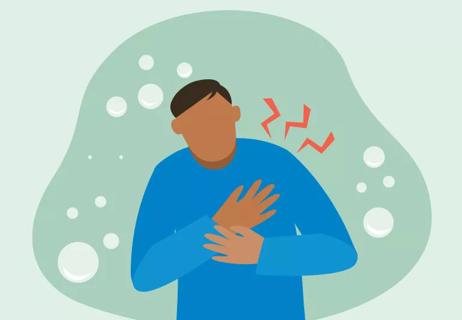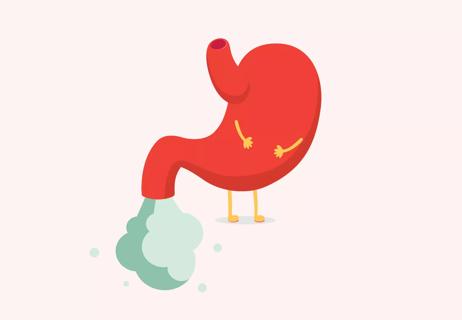Advertisement
Burping, gas drops and extra tummy time are just a few ways to help your wee one rip one

Gas happens. Older kids and adults do what they gotta do to relieve it (and follow it up with a well-mannered, “Excuse me,” if you’re lucky).
Advertisement
Cleveland Clinic is a non-profit academic medical center. Advertising on our site helps support our mission. We do not endorse non-Cleveland Clinic products or services. Policy
But newborns rely on their caregivers for just about everything, and sometimes, that includes getting out the burps and farts. Ah, the beauty of early parenthood!
A newborn or baby having gas isn’t something to worry about in itself. But a baby who’s showing discomfort because of gas is asking for some help from their caretakers.
We talked with pediatrician Amy Sniderman, MD, about why babies get gassy — and what you can do to help your little one get some relief.
Gas is a natural bodily function that’s usually caused by swallowing extra air. Infants may take in extra air when drinking from a bottle or breast, crying or sucking on a pacifier.
Gas discomfort is most common for their first four months or so; though, Dr. Sniderman says some babies will need help with their gas for a year or longer.
“Some babies just make a little more gas than others. And some may be working on learning to coordinate their bodily functions,” Dr. Sniderman says. “There’s a spectrum of what’s normal and what’s not when it comes to babies passing gas. Not every baby needs help, but some do. And that’s very normal.”
A newborn or baby having gas isn’t something to worry about in itself. Gas is simply part of life, from day one. But a baby with built-up gas is usually a less-than-happy baby. A belly full of bubbles just doesn’t feel good — and they’ll probably let you know it.
Advertisement
Babies who are trying to relieve their gas or move their bowels might:
Nobody wants to see their kiddo uncomfortable. Luckily, in the case of baby gas, there are plenty of things you can try to bring relief — both in the moment and long term. We’ve compiled nine pearls of wisdom to get you started.
Bottle design plays a big role in how much air your wee one swallows as they feed. For the best results, use an angle-neck bottle with a slow-flow nipple. Vented wands with internal straws are a great option, as are bottles that use pre-sterilized disposable drop-in liners.
Also be mindful that — if you’re formula feeding — the way you prepare baby’s bottle can make a difference, too. Instead of shaking the bottle to incorporate the formula (which turns baby’s food into an air bubble factory) stir or swirl it in. Then, wait a couple of minutes for the air bubbles that are there to rise to the top.
As much as possible (and it’s not always possible), try to offer your baby food before they’re hungry enough to cry about it. The gulping breaths little ones take while wailing fill their tiny tummies with air. They also take gulping breaths when they’re furiously gulping their food!
When babies drink, they swallow air in the process, which can lead to gas. Adjusting their feeding position may help. Dr. Sniderman suggests keeping your baby on a slight incline — so your little one’s head is higher than their stomach — during feedings. If holding your baby this way feels uncomfortable, use a nursing pillow for extra support.
Side note: If you’re not using an angle-neck bottle, make a point of tipping the bottle slightly upward. That angle should help prevent gas bubbles from entering the nipple. It also gives your baby more control over how fast they feed, which means less air in their tummy.
Taking the time to burp your kiddo will help minimize gas buildup.
“Typically, we suggest pausing about halfway through a feeding to try for a burp and then again at the end of a feeding session,” Dr. Sniderman says. “For babies that are more prone to gas, we might suggest burping more often — after each ounce or so.”
The two positions Dr. Sniderman most frequently recommends for burping are:
Advertisement
Side note: Whatever position you’re burping your baby in, Dr. Sniderman recommends burping them on their midback, in line with their upper abdomen.
“Many people burp up by their baby’s shoulders, which is really not low enough to help,” she clarifies.
Not every baby will burp with every feeding. Give them a chance to get it out, but if the burps aren’t coming, don’t sweat it, Dr. Sniderman says. If you really feel like your baby needs to burp or fart, tummy time is another great option for relieving gas.
Does baby need to fart? Get their legs moving to bring some relief. Dr. Sniderman suggests lying your baby on their back and moving their legs in gentle circular motions, as if they were riding a bicycle. Alternatively, place your baby on their back and hold their feet in your hands. Bend their legs at their knees and gently bring their knees to their bellies.
These methods may also help to bring on a poo.
“Some babies don’t know how to coordinate their anal musculature just yet. They’ll be pushing and crying out, but they’re actually clenching,” Dr. Sniderman explains. “Developmentally, they figure it out. But bicycling and flexing their legs to their bellies can really help in the meantime.”
Advertisement
Commonly known as gas drops, the medication simethicone has been used for years to relieve gas in infants. It can be bought over the counter and is U.S. Food and Drug Administration (FDA) approved to relieve gas in infants.
The effectiveness of gas drops can vary. They may not work for all babies and all gas, but they’re a safe option that may be worth a try.
Dr. Sniderman recommends the drops for some babies who are extra gassy. She also says gas drops should be used as a preventive measure, as they’re less effective after gas has already built up.
“Gas drops work by breaking up gas bubbles in babies’ tummies. If you’re going to use them, it’s best to use them about four times a day, regularly, to prevent gas, rather than use them reactively,” she explains. “If baby already has uncomfortable gas, it’s probably too late for gas drops to work.”
Gripe water is an over-the-counter herbal remedy for infant gas. It’s not a medication, so the FDA doesn’t regulate it. Dr. Sniderman also cautions that its safety and effectiveness haven’t been well researched.
“There are a lot of families who use it and I haven’t personally seen any problems with gripe water, but I generally don’t recommend it,” she says. “Without solid research to back it up, I can’t confidently say, ‘Yes, that’s fine.’”
Advertisement
If your baby drinks formula, you might consider trying new kinds to see if it helps relieve their gas. Some babies find relief from gas with a change in diet.
“If it’s just gas and the baby is otherwise doing fine, we sometimes recommend using a ‘sensitive formula’ with lower lactose or a partially hydrolyzed (broken-down) lactose formula,” Dr. Sniderman shares. “Those formulas are still milk-based, so they’re not for a baby with an allergy or intolerance to milk, but they sometimes can help babies who just have straightforward gas.”
If that doesn’t work, it doesn’t mean you’re out of options.
Some babies simply don’t tolerate typical formula. In those cases, a specialized formula that contains different proteins or carbohydrates may work better. These products often say something like, “May help with gas, fussiness or colic,” on their packaging. If you suspect your baby is having difficulty digesting their current formula, Dr. Sniderman recommends talking with your baby’s doctor about your options.
If you’re breastfeeding, you may have heard that what you eat affects your breast milk and that certain foods should be avoided. Proper nutrition is important when breastfeeding. But scientific research hasn’t conclusively proven a link between your diet and gas or other discomforts for your baby.
When breastfeeding, some people benefit from cutting back on gas-causing foods or dairy products. This can be especially helpful if they’re feeling gassy themselves. Dr. Sniderman says if it works for you, great, but she doesn’t suggest a restrictive diet for most breastfeeding mothers.
“Some people will come up with a long list of foods you should cut out of your diet if you have a gassy baby,” she continues. “That’s a lot to ask of someone who’s probably already stressed and taking care of a new baby. When you’re breastfeeding, you need to eat a lot. You literally have to eat enough to feed you and the baby. So, I am usually not of the camp that eliminates a lot of things from a breastfeeding diet.”
If any of the following situations crop up in addition to baby’s gas issues, you need to contact a healthcare provider immediately:
But remember: You don’t have to suspect something’s seriously wrong to take your little one to their pediatrician. Dr. Sniderman says you should also consult your baby’s doctor if gas is keeping them from doing … well, happy baby things.
“If gas is interrupting your baby’s ability to have a bowel movement or it’s interrupting their sleep or their feeding, then it’s a problem — and it’s time to reach out,” Dr. Sniderman states.
When you were pregnant, you probably daydreamed of the special moments you’d spend with your baby — feeding them, bathing them, snapping share-worthy snuggly newborn pics. You probably thought less about the joys brought on by a thunderous burp or an odorous fart.
But soon, you’ll realize that those post-gas smiles may just be some of their cutest moments. Get your camera ready.
Learn more about our editorial process.
Advertisement

When it can’t pass down south, gas can definitely travel — and get trapped — up north

Fiber gets credit, but don’t let the byproduct keep you from enjoying beans

Excessive flatulence could indicate a digestive issue

Delays in growth, stomach aches and bathroom issues are all symptoms of this serious digestive condition

Current research suggests 1 of every 31 children in the U.S. has ASD — and that’s probably an undercount

‘Social smiles’ typically start around 8 weeks old, while laughter comes later — around 4 to 6 months

Most infants can roll from tummy to back by 6 months old — but remember, every child develops at their own pace

If you’re feeling short of breath, sleep can be tough — propping yourself up or sleeping on your side may help

If you fear the unknown or find yourself needing reassurance often, you may identify with this attachment style

If you’re looking to boost your gut health, it’s better to get fiber from whole foods